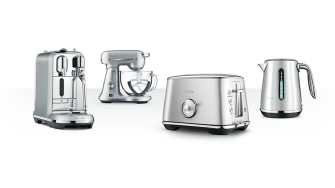
Industrial Design researchers are helping shape Breville Group's global approach to product design.
A team from UNSW School of Built Environment used co-design – a participatory and collaborative design methodology – to help Breville Group get insights into the way their new designs were perceived by customers.
Led by Industrial Design Professor Oya Demirbilek, the team from UNSW provided a methodology to validate and give direction to the design language of the Breville product range – in turn, helping to ensure the company’s new design direction was connecting with their customers in Australia and around the globe.
"There are so many products on the market at the moment. So how do you differentiate yourself? It's not only about the function of the product, it's about how the products are perceived," Professor Demirbilek says.
Breville Group is the largest Australian manufacturer of kitchen appliances, trading in more than 50 countries globally. According to Professor Demirbilek, the project helped the design team at Breville become more aware of how their product ranges are perceived and compared by consumers by partnering with them in a research project.
"Using a range of co-design methods, we were able to validate that the design language of their product range was being perceived positively and correctly by their users in terms of the quality of the Breville brand,” says Professor Demirbilek.
"By partnering with the users, we uncovered what they perceive in the Breville product lines, which will help better inform the design process for Breville. We were also able to provide design implications to support Breville in their design decision-making to better align their brand with the needs of their target market."
Co-design is a design-led problem-solving process to genuinely engage consumers, stakeholders and experts in design processes and in academic research, usually involving a mindset change from 'designing for', to 'designing with'.
As an intensively collaborative approach, it involves a careful selection of workshops, creative sessions, journaling, consultations and other engaging design research activities. The outcomes of the sessions vary depending on methodologies, but include: assessing specific aspects of products, capturing valuable user insights, new value propositions, design concepts and the meaning of product designs. The aim is to reveal the real needs of the modern consumer.
"We implemented a particular methodology in a pilot we designed specifically for this project and then in two more consecutive co-design workshops with consumers, testing the user's perception of the new Breville product ranges with a range of design research activities," Professor Demirbilek says. "The results of the workshops all confirmed that Breville is consistently meeting user requirements and doing the right things in terms of visual language and user perception."
The findings from the co-design workshops and the methodology are now being implemented in Breville product lines in Australia, as well as the USA and Germany.
"As a result of this work, recommendations and design implications have been taken and implemented into the design of their latest coffee maker, while all other products from the new range have also been validated in terms of their design language through this project."
Doug Nash, GM Product Management at Breville Australia, reached out to Professor Demirbilek in 2018 to initiate and lead the research project on the visual language perception of their product ranges at a national and international scale. He says the change in consumer trends towards products necessitated the change in approach.
"We were about to launch a refreshed range of products in the market, which was something we weren't going to do lightly. I knew about [Professor Demirbilek's] work as she is a well-published expert in product semiotics, and we were after something beyond what a traditional market research agency could offer."
Mr Nash says the co-created research project developed by Professor Demirbilek provided crucial insights into how consumers would read the new range of Breville products.
"Because we're operating in a space that needs to be more understood, having the academic lens meant we were able to get the deeper insights and recommendations we needed, and that were grounded in research,” he says.
"It was a very hands-on series of workshops, designed specifically to elicit responses beyond the limitations of vocabulary, to how consumers really felt about our new range. We learnt were on the right track, with some specific findings that have resonance for the design team regarding how consumers respond to the products, which has informed the design direction and research at Breville.”
Mr Nash says the collaboration with UNSW School of Built Environment has left a lasting impact on Breville.
"Working with [Professor Demirbilek's] team ensured we didn't lose what makes our products so special. In turn, it has helped inform our entire range today."
